Mortality and kidnapping estimates for the Yazidi population in the area of Mount Sinjar, Iraq, in August 2014: A retrospective household survey
Valeria Cetorelli and colleagues document the extent of the ISIS-led killings and kidnappings of the Yazidi population in 2014.
Published in the journal:
. PLoS Med 14(5): e32767. doi:10.1371/journal.pmed.1002297
Category:
Research Article
doi:
https://doi.org/10.1371/journal.pmed.1002297
Summary
Valeria Cetorelli and colleagues document the extent of the ISIS-led killings and kidnappings of the Yazidi population in 2014.
Introduction
During the summer of 2014, the so-called Islamic State of Iraq and Syria (ISIS) subjugated Nineveh governorate in Northern Iraq. Nineveh has historically been home to most of Iraq’s minority groups, including Yazidis, Assyrian and Chaldean Christians, Sabaean-Mandaeans, Turkmen, Shabak, and Kaka’i. These minorities were systematically targeted by ISIS in its violent campaign to “purify” the region from non-Islamic influences [1]. Yazidis, whom ISIS militants consider “devil worshippers,” were singled out for particularly brutal treatment [2].
The Yazidis practice an ancient religion that contains elements of Zoroastrianism, Judaism, Christianity, and Islam. They number less than 1.5 million, living mainly in Iraq, Syria, Turkey, and Armenia. The largest Yazidi community—approximately 400,000 people—resided in the area of Mount Sinjar, some 150 km west of Mosul in Nineveh governorate (Fig 1) [3,4]. The Yazidis of Sinjar have long been one of the most vulnerable and impoverished communities in Iraq. After having suffered from decades of discrimination, marginalisation, and neglect during Saddam Hussein’s regime, in recent years they have experienced increasing persecution by Sunni extremists [5].
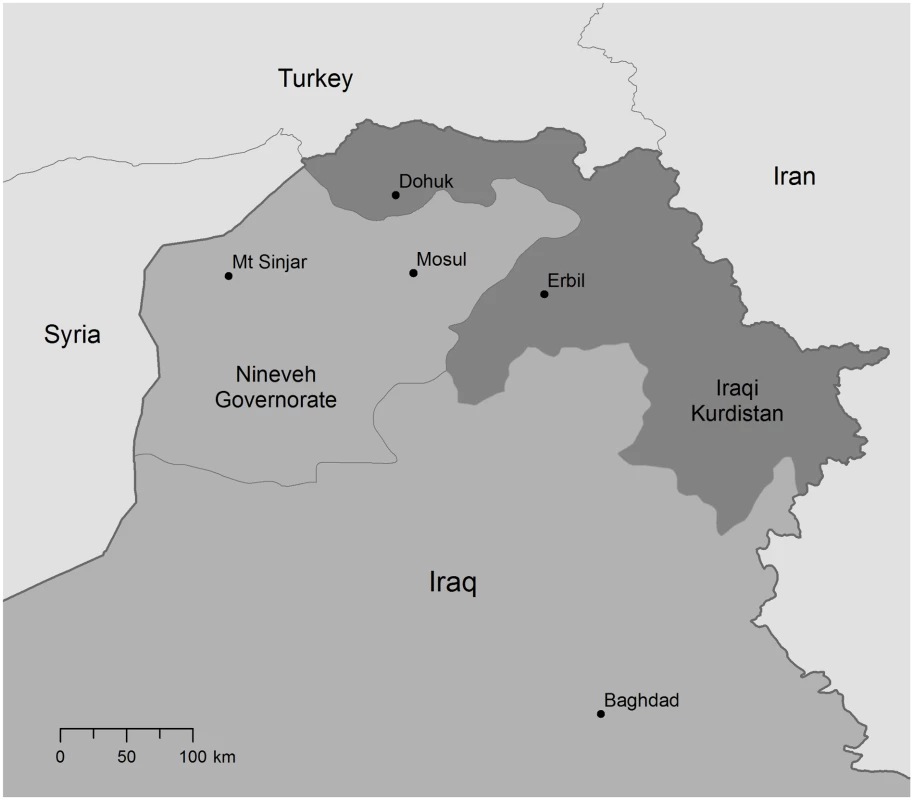
On 3 August 2014, ISIS launched a coordinated attack on Sinjar City and surrounding towns and villages, forcing Yazidis to seek refuge on Mount Sinjar. Those who could not flee in time were either killed or kidnapped [6]. As ISIS encircled the mountain on 4 August, tens of thousands of Yazidis remained trapped without water, food, or shelter in temperatures rising above 50°C. At the request of the Iraqi government, United States airstrikes and humanitarian aid airdrops began on 8 August; helicopter rescue missions were initiated a few days later. Most Yazidis were evacuated between 9–13 August when a safe corridor was opened by Kurdish forces, allowing them to flee through Syria into the Kurdistan Region of Iraq [7].
The vast majority of Yazidis reached Kurdistan by mid-August 2014, where they found temporary shelter in hundreds of informal settlements, including schools, community spaces, and unfinished buildings. As schools were needed for the beginning of the academic year and some property owners requested the government to clear their properties, displaced Yazidis were gradually transferred to newly built camps [8]. More than 300,000 Yazidis have settled in Kurdistan, with over half in camps managed by the Kurdistan regional government and the balance still scattered in construction sites and unofficial tented settlements [8,9]. A relatively low number of Yazidis have settled elsewhere: by 2015, it was estimated that some 10,000 remained in tents on the north side of Mount Sinjar under Kurdish control, nearly 15,000 were reportedly in refugee camps in Syria, and at least 30,000 were known to have crossed into Turkey [10–12].
Soon after the events of August 2014, the United Nations Human Rights Council dispatched a mission to Kurdistan to document the scope of ISIS violations of international human rights law. The mission report asserts that “members of ISIS may have perpetrated genocide against the Yazidi community by killing, causing serious bodily or mental harm and forcibly transferring members of the group, including children, in the context of a manifest pattern of conduct aimed at the destruction of the group” and that “further investigation is needed to establish the precise number of those who continue to be held by ISIS as well as the numbers killed, estimated to be in the thousands” [13].
Some attempts have been made to compile lists of those affected. Kurdish authorities and human rights organisations have reported to the United Nations that between 2,000 and 5,500 Yazidis were killed and more than 6,000 were kidnapped; however, the United Nations has not yet been able to independently verify these figures [14]. Between 4 November and 25 December 2015, we conducted a retrospective household survey to provide the first population-based estimates of the number and demographic profile of Yazidis killed and kidnapped by ISIS.
Methods
Ethical approval
The study received ethical approval from the Middle East Centre Committee of the London School of Economics and Political Science, London, United Kingdom and the Ethics Committee of the Hawler Medical University, Erbil, Kurdistan Region of Iraq. Permission to conduct the survey was granted by the Kurdish Board of Relief and Humanitarian Affairs, Dohuk, Kurdistan Region of Iraq. Analysis of the data was declared exempt by the Institutional Review Board of the Johns Hopkins Bloomberg School of Public Health, Baltimore, Maryland, US.
Data collection
The survey covered the displaced Yazidi population from Sinjar residing in camps in the Kurdistan Region of Iraq. As of December 2015, the Kurdish Board of Relief and Humanitarian Affairs (BRHA) managed 13 camps—Bajed Kandala, Bardarash, Bersive, Chamisku, Dawdiya, Essian, Garmawa, Karbato, Khanke, Mamilian, Rwanga, Shariya, and Sheikhan—hosting about 200,000 internally displaced persons (IDPs) from Nineveh governorate, predominantly Yazidis. Maps were available for all camps. All shelters (tents or prefabricated caravans) within camps were numbered.
We selected a stratified systematic random sample of 100 households per camp, yielding a total of 1,300 households. For each camp (stratum), we determined a sampling interval k as the ratio of camp size to sample size. We chose a random number from 1 to k to identify a starting household and selected every kth household thereafter. We defined a household as a group of people living together in one shelter. By this definition, a household corresponded in most cases to a nuclear family, but if multiple nuclear families were living in one shelter, they were still regarded as one household. In all camps, nuclear families with more than six members were given two adjacent tents or caravans; these nuclear families were regarded as one household, even though they occupied two shelters.
The questionnaire was designed to gather information about the current household composition and the age and sex of any household member who was killed or kidnapped by ISIS. Similar retrospective questionnaires have been used extensively to collect data on violence and mortality in conflict-affected populations [15–22]. To avoid double counting, respondents were asked to only report persons killed and kidnapped from their household (i.e., from the nuclear family or families living in that shelter). The relation to respondent for each reported household member was recorded. If killings of household members were reported, the circumstances of death were queried. Respondents were asked to specify whether the deceased was executed or died on Mount Sinjar during the ISIS siege. If kidnappings were reported, respondents were asked whether the person had escaped ISIS captivity or was still missing at the time of the survey. The health status of surviving household members was also queried (the health section of the survey will be published elsewhere).
The questionnaire was first drafted in English, then translated to Arabic, and then translated back to English. A focus group was organised at the Hawler Medical University to discuss major issues in content, translation, and interview flow. We revised the questionnaire based on the focus group discussion and agreed upon a consensus translation. This version of the questionnaire was pilot tested in 100 households in Shariya camp a few days before starting the survey, and final changes were made based on data evaluation and feedback from interviewers.
The field team consisted of four pairs of local Yazidi interviewers (one male and one female) and one survey supervisor. Before the pilot, the interviewers were given a three-day training session concerning the questionnaire, sampling methods, data collection using tablets, interview techniques, and basic protection principles for human subjects.
Fieldwork took place between 4 November and 25 December 2015. Interviews were conducted with the household head or a responsible adult in the household. The interviewers obtained verbal informed consent from all participants after reading a consent form outlining the purpose of the survey, its confidentiality, and the voluntary nature of participation. If no suitable informant was present in the household, an attempt was made to revisit the household later on the same day. In case of noncontact or refusal to participate, the interviewers were instructed to conduct an interview with the household living in the nearest tent or caravan. To protect the anonymity of respondents, no unique identifiers were recorded. Data were collected on tablets using Magpi 2.0. The survey supervisor was responsible for checking questionnaires for completion and quality before transmitting records from tablets to the Magpi web account.
Statistical analysis
Data analysis was performed using Stata 14 and R 3.2, applying standard adjustment methods for unequal probability stratified sampling and a finite population correction factor [23]. Inverse probability weights were used to account for the fact that a sample of the same size was drawn from each camp but camp sizes varied from 900 to 6,000 shelters. Households occupying two shelters (i.e., those having more than six members) were reweighted to adjust for the fact that they had a higher probability of being selected into the survey.
We estimated the probability of being killed or kidnapped by dividing the number of reports by the number of sampled Yazidis at risk (i.e., excluding those born after the events on Mount Sinjar). We did not attempt to estimate the daily rate of killings and kidnappings because the exact timing of events as well as how many Yazidis were at risk at any given moment is unknown in sufficient detail. To obtain the overall toll of killings and kidnappings, those probabilities were multiplied by the total Yazidi population living in Sinjar at the time of the ISIS attack, estimated at roughly 400,000 by the United Nations and Kurdish officials [3,4]. The demographic profile of those killed and kidnapped was examined, distinguishing between children and adults and females and males. Consistent with previous surveys in Iraq, we defined children as those under 15 y of age [19–22].
Our estimates are based on the assumption that Yazidis residing in BRHA camps are representative of all Yazidis from Sinjar in terms of their exposure to the ISIS attack. We believe this assumption is reasonable given the somewhat random process through which some families were transferred from informal settlements (i.e., schools and unfinished buildings that needed to be vacated) to official camps [8]. There is no indication that in-camp and out-of-camp Yazidis are different in their exposure to the events of August 2014. On the contrary, the United Nations has provided evidence that the ISIS attack was unexpected and all Yazidis living in Sinjar were targeted [3]. The uncertainty associated with inference from a sample of in-camp households must nevertheless be acknowledged. Without a sampling frame, those Yazidis who were still scattered in informal settlements could not be included in the survey. The relatively low proportion of Yazidis who have settled elsewhere than in Kurdistan could not be included either.
Survival bias is a source of concern in this context, as there is evidence that killings and kidnappings were clustered within nuclear families. This is because those families who could not flee in time were generally captured together. Since nuclear families with no survivors had zero probability of being selected and reported in the survey, the number of killings and kidnappings is likely underestimated in our data. How large the downward bias is depends on the extent to which killings and kidnappings were clustered within families as well as the distribution of family sizes in the Yazidi population. The greater the number of families captured together and the larger those families are, the greater the underestimate.
We conducted a sensitivity analysis to assess what the underestimate of the total number of killings and kidnappings would be depending on the proportion of zero-survivor families in the Yazidi population. We simulated 10,000 random samples from a mixture distribution of family size (ni) and proportion of missing family members (pi), drawing the number of killings and kidnappings in each ith family from a Binomial(ni, pi) distribution. The distribution of family sizes was obtained by bootstrapping, whereas the family-specific proportion of killings and kidnappings was drawn from a Beta(α, β) distribution, where α and β were fitted to the data using the method of moments. This model accounts for the greater variability (overdispersion) in our data, relative to a standard binomial model, because of the clustering of killings and kidnappings within families [24]. We obtained a sampling distribution of the overall proportion of killings and kidnappings by summing those events in each pseudosample and dividing the total by the number of individuals at risk. We used the number of nuclear families captured together in which at least one member escaped as a reference group, and we simulated what the toll of killings and kidnappings would be if a similar number of families were still in captivity or had died in their entirety with no one surviving to report.
Results
Sample characteristics
Of the 1,300 interviewed households in BRHA camps, 988 were Yazidi from Sinjar and 19 were Yazidi from the Nineveh Plain. The rest of the sample consisted of 105 Shabak, 6 Turkmen, 83 Sunni Kurd, 86 Sunni Arab, and 13 Assyrian Christian households. All households had been displaced from their homes in Nineveh governorate during the ISIS attack. Ninety-three of the selected households (7.2%) were replaced with households living in the nearest shelter because responsible adults were absent (6.5%) or refused to be interviewed (0.7%). The 988 Yazidi households from Sinjar contained 6,572 living residents at the time of the survey. The other 312 displaced households had 1,788 living residents (Table 1).

Yazidi interviewees from Sinjar reported 43 killings and 83 kidnappings of household members by ISIS. Twenty-two household members were executed—either shot, beheaded or burned alive—while 21 died from lack of water and food or injuries during the ISIS siege on Mount Sinjar. Of the 83 kidnapped, 45 had escaped ISIS captivity by the time of the survey while 38 were still missing. Killings and kidnappings included children and adults and females and males (Tables 2 and 3). Among others interviewed, one killing attributed to ISIS was reported by a Sunni Arab household from the Nineveh Plain and two kidnappings were reported by Shabak households from Mosul. In all three cases, the dead or missing person was an adult male.


Population estimates
Table 4 shows the estimated probabilities of killings and kidnappings of Yazidis by ISIS. Nearly 25 out of 1,000 people were either killed or kidnapped (95% CI 17.5–34.6). The likelihood of being killed was 7.6 per 1,000 (95% CI 5.3–11.0) and the likelihood of being kidnapped 17.0 per 1,000 (95% CI 10.7–26.9). Fig 2 displays the estimated toll of killings and kidnappings, assuming a Yazidi population of 400,000 in Sinjar at the time of the ISIS attack. The overall estimated toll is 9,900 (95% CI 7,000–13,900) people. An estimated 3,100 (95% CI 2,100–4,400) Yazidis were killed: 1,400 (95% CI 800–2,300) were executed, and 1,700 (95% CI 1,000–2,900) died on Mount Sinjar during the ISIS siege. The estimated number kidnapped is 6,800 (95% CI 4,200–10,800). At the time of the survey, an estimated 4,300 (95% CI 2,400–7,800) Yazidis had escaped captivity, while an estimated 2,500 (95% CI 1,100–5,500) were still missing.

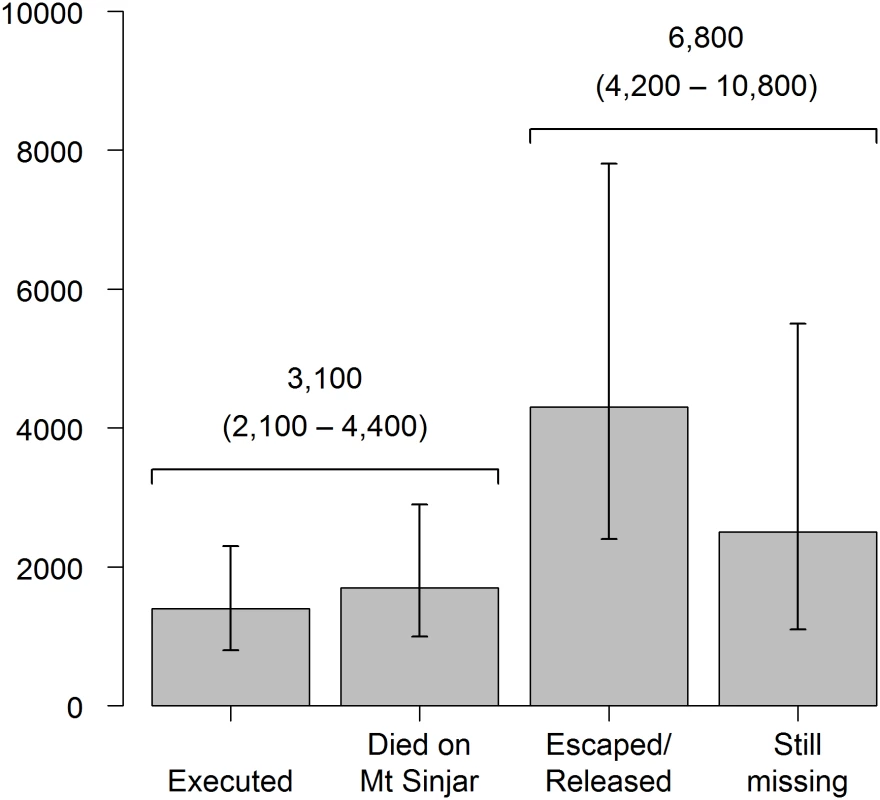
Killings and kidnappings were highly clustered—6.7% of nuclear families in the sample accounted for all these events. Of those nuclear families with at least one killing or kidnapping, 13.2% had all members either killed or kidnapped but were reported in the sample because at least one family member managed to escape ISIS captivity. In other words, nearly 1% of the nuclear families in our sample were captured in their entirety. Had there been no one to escape and report their fate, our estimate of the total number of killings and kidnappings would have been 21.7% lower, suggesting that the potential underestimate is large.
Fig 3 shows the sensitivity of our estimate to the potential number of zero-survivor families. The proportion of nuclear families in the sample who were captured in their entirety but subsequently had one or more members escape provides a useful point of reference. If an equal number of nuclear families are still missing, the toll of killings and kidnappings would be 12,900 (95% CI 9,000–17,300). Although the expected toll of killings and kidnappings increases linearly as a function of the number of zero-survivor families, as expected, the confidence band surrounding that number tends to widen. Contributing to the rising uncertainty are the clustering of killings and kidnappings within families and, to a lesser extent, the variation in family size in the population.
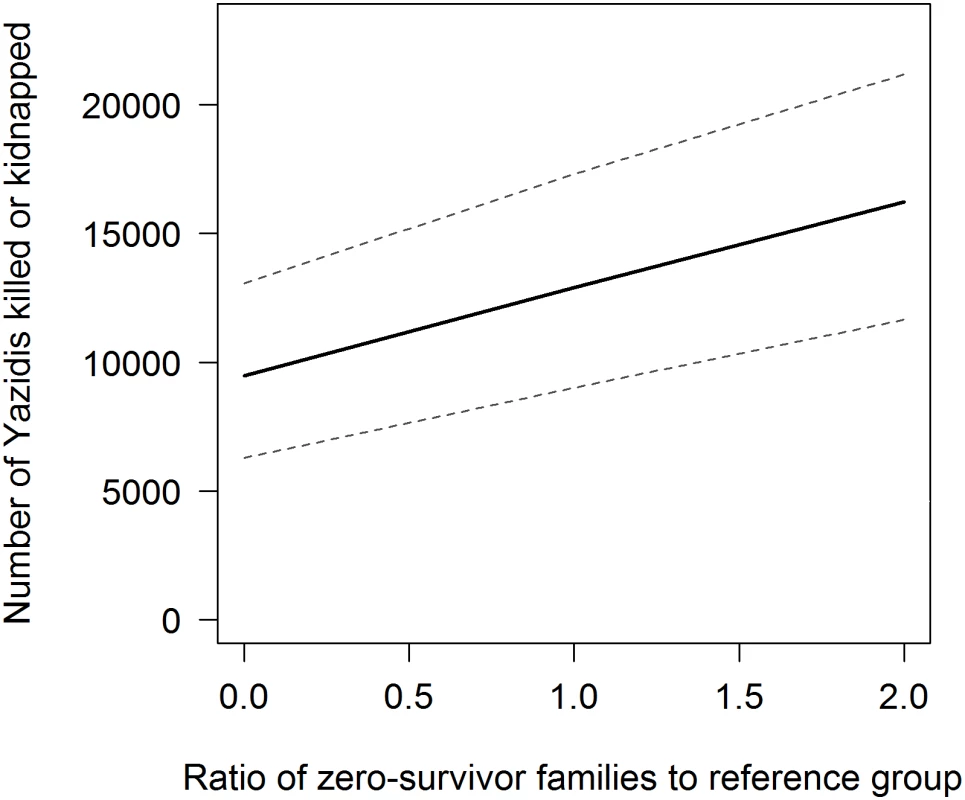
Figs 4 and 5 outline the age and sex profile of Yazidis killed and kidnapped. At the time of the ISIS attack, the proportion of children under 15 y within the population was 41.2% (95% CI 39.6–42.9), and the proportion of females of all ages was 49.4% (95% CI 48.3–50.6). Children were disproportionately affected by ISIS violence. They were as likely as adults to be executed (95% CI 17.6–62.3) but constituted 93.0% (95% CI 71.9–98.6) of those who died on Mount Sinjar. Moreover, children only accounted for 18.8% (95% CI 8.4–36.9) of those who managed to escape captivity. Females were as likely as males to be executed (95% CI 22.7–67.2) and to die on Mount Sinjar (95% CI 34.6–79.8). They were also as likely to be kidnapped and still missing (95% CI 34.2–69.9).
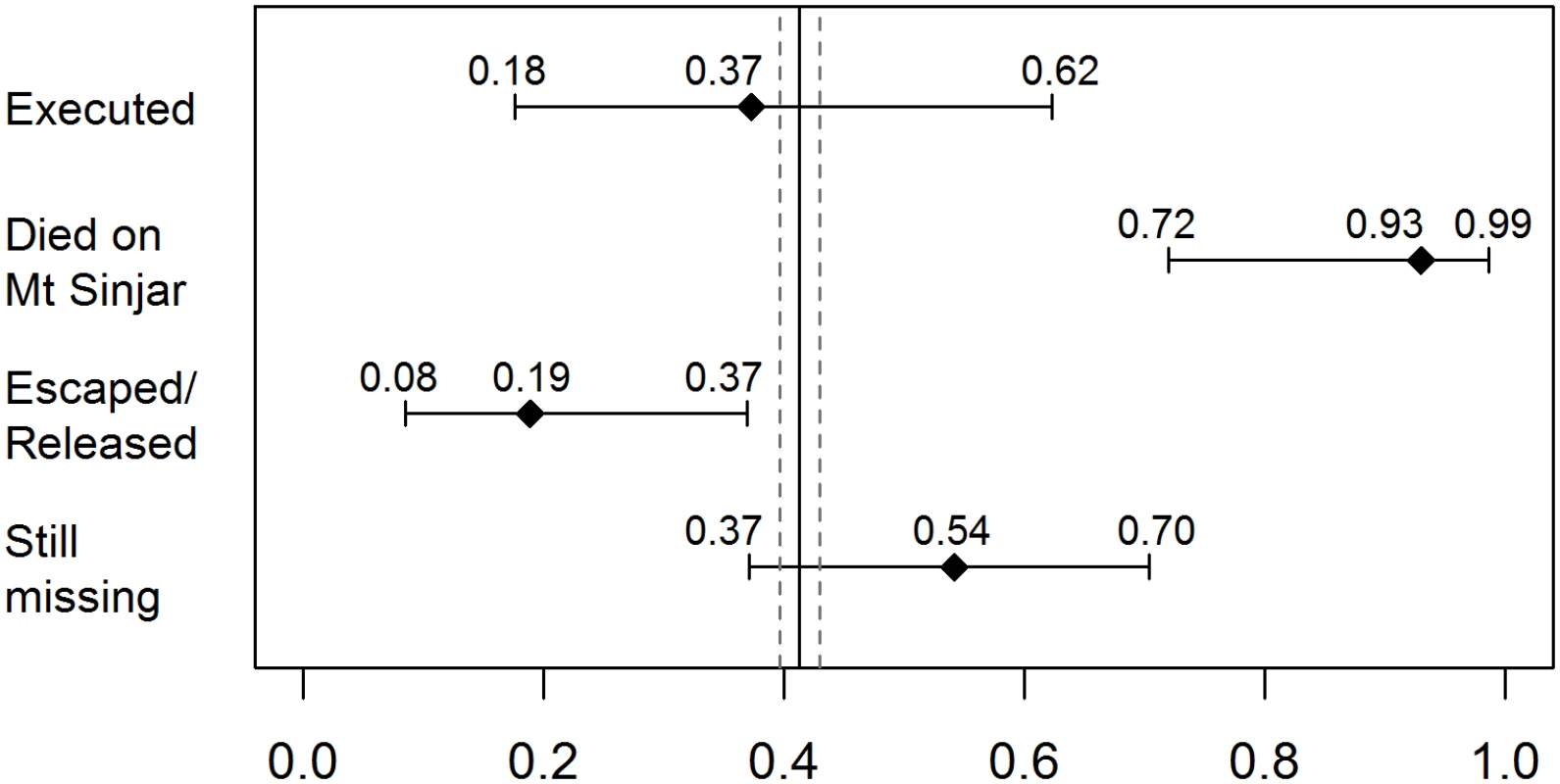
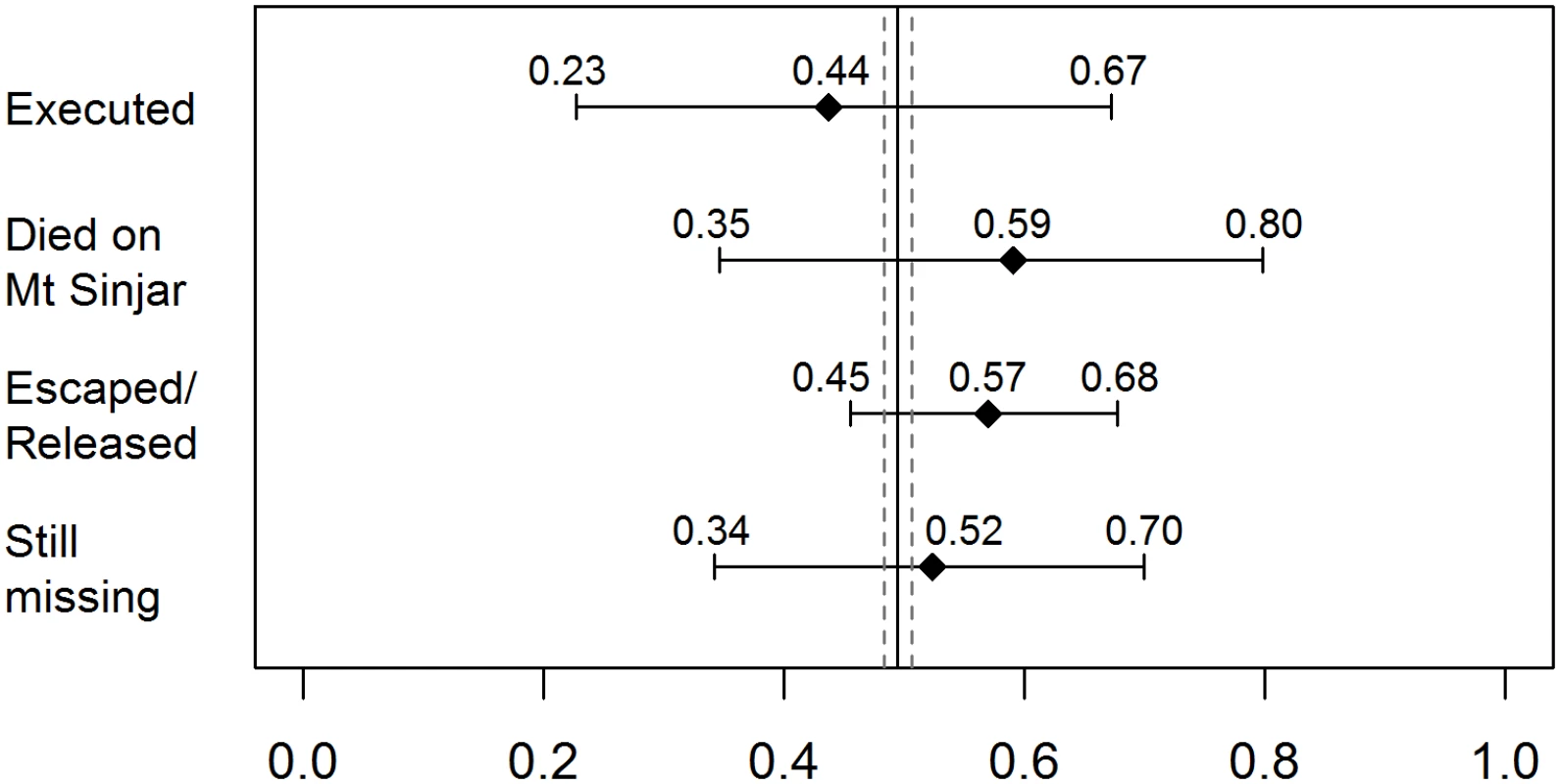
Discussion
The Yazidi religious minority of Sinjar was devastated by the ISIS attack of August 2014. We estimate that 2.5% of the Yazidi population was either killed or kidnapped over the course of just a few days. Other minority groups in Nineveh governorate were also attacked on the basis of their religious identities and forced to flee their homes, but the scale of killings and kidnappings was not as high [2,3]. The Yazidis have long faced discrimination in Iraq and in recent years have experienced increasing persecution by Sunni extremists. In 2007, two Yazidi villages were completely destroyed in the single most devastating Islamist terror attack since the beginning of sectarian conflict in the country [5].
While violent deaths in Iraq have been typically concentrated among adult men [19–22,25], our data show that Yazidis were targeted by ISIS regardless of age and sex. Executions were indiscriminate, including children and adults and females and males. This finding is confirmed by the discoveries of 35 mass graves containing the remains of hundreds of Yazidi men, women, and children in the Sinjar area that has been taken back from ISIS [26]. Our data show that nearly all of those who died on Mount Sinjar from starvation, dehydration, or injuries during the ISIS siege were children. This finding is consistent with a UNICEF statement on 5 August 2014 expressing extreme concern for up to 25,000 children stranded on the mountain “in dire need of humanitarian aid including drinking water and sanitation services” [27]. Similar warnings appeared in contemporary news reports [28].
Kidnappings were also indiscriminate. Families in captivity were separated and forcibly transferred to different locations in ISIS-controlled territory. Escapees recounted the abuses they had suffered, including forced religious conversion, torture, and sex slavery. The outcomes of kidnapping varied. Children under 15 y of age were much less likely to escape captivity than adults. Several accounts confirm that girls were sold or gifted to ISIS fighters, while boys were forced to attend ISIS training camps [3,29–31]. It is currently impossible to establish how many of those still missing are alive.
We estimate that 3,100 (95% CI 2,100–4,400) Yazidis were killed and 6,800 (95% CI 4,200–10,800) were kidnapped. These figures are aligned with the most recent counts reported to the United Nations by Kurdish authorities and human rights organisations (i.e., between 2,000 and 5,500 killings and more than 6,000 kidnappings) [14]. The fact that multiple independent sources arrived at similar estimates increases our confidence in the general findings [32].
Nevertheless, this survey has some limitations that must be acknowledged. First, our estimates are based on a random sample of Yazidi households residing in BRHA camps, assuming that their exposure to the ISIS attack is representative of the experience of the whole Yazidi population from Sinjar. This assumption seems reasonable given the unexpected and indiscriminate nature of the attack and the somewhat random process thought which some of the displaced Yazidis were transferred from informal settlements to official camps [3,8]. However, the possibility of a higher or lower proportion of killings and kidnappings among Yazidis who are still scattered in informal settlements in Kurdistan or among those who have settled elsewhere cannot be completely ruled out, and a survey of out-of-camp households cannot be conducted under the present circumstances. Further uncertainty in our estimates is introduced by the reliance on a rough figure of 400,000 for extrapolation to the Yazidi population of Sinjar at the time of the attack, as the exact number is unknown [3,4].
We believe that the actual toll of killings and kidnappings may be underestimated in our data because of survival bias. A retrospective survey requires at least one surviving member to report killings and kidnappings in the family; hence, it is precisely the families with the largest number of members killed or still in captivity which are excluded from our sample. Although the number of zero-survivor families is unknown, it is possible that it is in the vicinity of the number of families captured together who later escaped, whether in whole or in part. If this is the case, the overall toll of killings and kidnappings would be higher than our estimate by several thousands. New measurement methods need to be developed to address the problem of survival bias in crisis settings, particularly in contexts where families tend to be targeted as a whole.
Conclusion
On the occasion of the second anniversary of the August 2014 attack, the United Nations Human Rights Council has declared that the ISIS violence against Yazidis constitutes a case of ongoing genocide, calling for a refocus of attention on the rescue, protection, and care of the Yazidi community and recommending the Security Council to refer the case to the International Criminal Court or an ad hoc tribunal with relevant geographical and temporal jurisdiction [33]. The Convention on the Prevention and Punishment of the Crime of Genocide defines genocide as “any of the following acts committed with intent to destroy, in whole or in part, a national, ethnical, racial or religious group, as such: (a) killing members of the group; (b) causing serious bodily or mental harm to members of the group; (c) deliberately inflicting on the group conditions of life calculated to bring about its physical destruction in whole or in part; (d) imposing measures intended to prevent births within the group; (e) forcibly transferring children of the group to another group” [34]. A United Nations Commission of Inquiry has recently determined that “ISIS has committed, and is committing, the prohibited acts with the intent to destroy, in whole or in part, the Yazidis of Sinjar” [3]. Population-based estimates from our survey confirm the severity of the ISIS attack against the Yazidis. Combined with other existing evidence, these estimates can contribute to documenting the full scale of violations and holding perpetrators accountable for their actions.
Supporting Information
Zdroje
1. Amnesty International. Ethnic cleansing on a historic scale: Islamic State’s systematic targeting of minorities in Northern Iraq. Amnesty International Report; 2014. https://www.es.amnesty.org/uploads/media/Iraq_ethnic_cleansing_final_formatted.pdf
2. Simon-Skjodt Center for the Prevention of Genocide. “Our Generation is gone.” The Islamic State’s targeting of Iraqi minorities in Ninewa. Bearing Witness Trip Report; 2015. https://www.ushmm.org/m/pdfs/Iraq-Bearing-Witness-Report-111215.pdf
3. OHCHR. “They came to destroy”: ISIS Crimes Against the Yazidis. A/HRC/32/CRP.2; 2016. http://www.ohchr.org/Documents/HRBodies/HRCouncil/CoISyria/A_HRC_32_CRP.2_en.pdf
4. EKurd Daily. Iraqi Kurdistan says 400,000 Yazidi Kurds were displaced from Sinjar district. EKurd Daily; 2015. http://ekurd.net/400000-displaced-yazidi-kurds-in-kurdistan-2015-08-05
5. Maisel S. Social Change Amidst Terror and Discrimination: Yezidis in the New Iraq. The Middle East Institute Policy Brief. 2008;18. https://www.files.ethz.ch/isn/90905/No_18_Social_Change_Amidst_Terror.pdf
6. Yazda and Free Yazidi Foundation. ISIL: Nationals of ICC states parties committing genocide and other crimes against the Yazidis. Requesting the commencement of a preliminary examination in the situation involving genocide and other crimes committed against the Yazidis in Sinjar and Nineveh Plain. Report submitted to the Office of the ICC Chief Prosecutor in The Hague; 2015. https://www.yazda.org/wp-content/uploads/2015/09/RED-ISIL-commiting-genocide-against-the-Yazidis.pdf
7. REACH. Displacement from Sinjar, 3–14 August 2014. REACH Overview Report; 2014. http://www.reach-initiative.org/wp-content/uploads/2014/08/REACH_IRQ_InternalDisplacement_Briefing_August2014_Sinjar.pdf
8. Board of Relief and Humanitarian Affairs. Report on IDP camps in Duhok. BRHA Report; 2015. http://www.brha-duhok.org/wp-content/uploads/Report%20on%20the%20IDP%20camps%20in%20Dohuk-June%202015.pdf
9. Kurdistan Regional Government. More than 300 thousand displaced Yezidi Kurds in Kurdistan Region. KRG Press Release; 2014. http://cabinet.gov.krd/a/d.aspx?s=040000&l=12&a=52545
10. EKurd Daily. One doctor for 10,000 people in Iraq’s Yazidi Mount Sinjar. EKurd Daily; 2015. http://ekurd.net/one-doctor-for-10000-people-in-iraqs-yazidi-mount-sinjar-2015-01-13
11. Sidky M, Rummery A. UNHCR steps up aid as Yazidis stream into Syria from Iraq's Mount Sinjar. Dobbs L, editor. UNHCR; 2014. http://www.unhcr.org/uk/news/latest/2014/8/53ecb7a29/unhcr-steps-aid-yazidis-stream-syria-iraqs-mount-sinjar.html
12. Daloglu T. How will Turkey react to stream of Kurdish refugees? Al Monitor; 2014. http://www.al-monitor.com/pulse/originals/2014/09/turkey-syria-iraq-kobani-isis-kurds-pkk.html
13. OHCHR. Report of the Office of the United Nations High Commissioner for Human Rights on the human rights situation in Iraq in the light of abuses committed by the so-called Islamic State in Iraq and the Levant and associated groups. A/HRC/28/18; 2015. http://dag.un.org/bitstream/handle/11176/310221/A_HRC_28_18-EN.pdf?sequence=1&isAllowed=y
14. UNAMI/OHCHR. A call for accountability and protection: Yezidi survivors of atrocities committed by ISIL. UNAMI/OHCHR Report; 2016. http://www.ohchr.org/Documents/Countries/IQ/UNAMIReport12Aug2016_en.pdf
15. Spiegel PB, Salama P. War and mortality in Kosovo, 1998–99: An epidemiological testimony. Lancet. 2000;355:2204–2209. doi: 10.1016/S0140-6736(00)02404-1 10881894
16. Grein T, Checchi F, Escribè JM, Tamrat A, Karunakara U, Stokes C, Brown V, Legros D. Mortality among displaced former UNITA members and their families in Angola: a retrospective cluster survey. BMJ. 2003;327:1–5.
17. Depoortere E, Checchi F, Broillet F, Gerstl S, Minetti A, Gayraud O. Violence and mortality in West Darfur, Sudan (2003–05): Epidemiological evidence from four surveys. Lancet. 2004;364:1315–1320. 15474133
18. Coghlan B, Brennan RJ, Ngoy P, Dofara D, Otto B, Clements M, Stewart T. Mortality in the Democratic Republic of Congo: A nationwide survey. Lancet. 2006;367:44–51. doi: 10.1016/S0140-6736(06)67923-3 16399152
19. Roberts L, Lafta R, Garfield R, Khudhairi J, Burnham G. Mortality before and after the 2003 invasion of Iraq: Cluster sample survey. Lancet. 2004;364:1857–1864. doi: 10.1016/S0140-6736(04)17441-2 15555665
20. Burnham G, Lafta R, Doocy S, Roberts L. Mortality after the 2003 invasion of Iraq: A cross-sectional cluster sample survey. Lancet. 2006;368:1421–1428. doi: 10.1016/S0140-6736(06)69491-9 17055943
21. Alkhuzai AH, Ahmad IJ, Hweel MJ, Ismail TW, Hasan HH, Younis AR, Shawani O, Al-Jaf VM, Al-Alak MM, Rasheed LH, Hamid SM, Al-Gasseer N, Majeed FA, Al Awgati NA, Ali MM, Boerma JT, Mathers C. Violence related mortality in Iraq from 2002 to 2006. NEJM. 2008; 358:484–493. doi: 10.1056/NEJMsa0707782 18184950
22. Hagopian A, Flaxman AD, Takaro TK, Esa Al Shatari SA, Becker S, Levin-Rector A, Galway L, Hadi Al-Yasseri, Weiss WM, Murray CJ, Burnham G. Mortality in Iraq associated with the 2003–2011 War and Occupation: Findings from a national cluster sample survey by the University Collaborative Iraq Mortality Study. PLoS Med. 2013;10(10):e1001533. doi: 10.1371/journal.pmed.1001533 24143140
23. Heeringa SG, West BT, Berglund PA. Applied survey data analysis. London: CRC Press; 2010.
24. Hinde J, Demetrio CG. Overdispersion: models and estimation. Computational Statistics and Data Analysis. 1998;27(2):151–70.
25. Hicks MH, Dardagan H, Guerrero Serdan G, Bagnall PM, Sloboda JA, Spagat M. Violent deaths of Iraqi Civilians, 2003–2008: Analysis by perpetrator, weapon, time, and location. PLoS Med. 2011;8(2):e1000415. doi: 10.1371/journal.pmed.1000415 21358813
26. Yazda. Mass graves of Yazidis killed by the Islamic State organization or local affiliates on or after August 3, 2014. Yazda Documentation Project; 2016. http://www.yazda.org/wp-content/uploads/2016/01/Yazda-Report-on-Mass-Graves-Jan-28-2016.pdf
27. Babille M. Statement on child deaths in Iraq. UNICEF Press Centre; 2015. https://www.unicef.org/media/media_74676.html
28. Sherlock R, Malouf C. At least 300 people, mostly children, died on Mount Sinjar, say doctors. The Telegraph; 2014. http://www.telegraph.co.uk/news/worldnews/middleeast/iraq/11036425/At-least-300-people-mostly-children-died-on-Mount-Sinjar-say-doctors.html
29. Amnesty International. Escaped from hell. Torture and sexual slavery in Islamic State captivity in Iraq. Amnesty International Report; 2014. https://www.amnesty.org.uk/files/escape_from_hell_-_torture_and_sexual_slavery_in_islamic_state_captivity_in_iraq_-_english_2.pdf
30. Human Rights Watch. Iraq: ISIS escapees describe systematic rape. Yazidi survivors in need of urgent care. Human Rights Watch Report; 2015. https://www.hrw.org/news/2015/04/14/iraq-isis-escapees-describe-systematic-rape
31. Qasem M, Qirani R. Islamic State trained Yazidi children as soldiers. Al Monitor; 2015. http://www.al-monitor.com/pulse/security/2015/11/yazidi-children-islamic-state-soldiers.html
32. Klingner J, Silva R. Combining found data and surveys to measure conflict mortality. In: Taylor B, Seybolt TB, Aronson JD, Fischhoff B. Counting civilian casualties: An introduction to recording and estimating non-military deaths in conflict. Oxford: Oxford University Press; 2013.
33. OHCHR. Statement by the Commission of Inquiry on Syria on the second anniversary of 3 August 2014 attack by ISIS of the Yazidis; 2016. http://www.ohchr.org/EN/NewsEvents/Pages/DisplayNews.aspx?NewsID=20330&LangID=E
34. UN General Assembly. Convention on the prevention and punishment of the crime of genocide. Resolution 260/3; 1948. http://www.refworld.org/docid/3ae6b3ac0.html
Štítky
Interní lékařstvíČlánek vyšel v časopise
PLOS Medicine
2017 Číslo 5
- Příznivý vliv Armolipidu Plus na hladinu cholesterolu a zánětlivé parametry u pacientů s chronickým subklinickým zánětem
- Berberin: přírodní hypolipidemikum se slibnými výsledky
- Léčba bolesti u seniorů
- Flexofytol® – přírodní revoluce v boji proti osteoartróze kloubů
- Nutraceutikum Armolipid Plus podle klinických důkazů zlepšuje lipidový profil − metaanalýza
Nejčtenější v tomto čísle
- Vitamin D levels and susceptibility to asthma, elevated immunoglobulin E levels, and atopic dermatitis: A Mendelian randomization study
- Maternal age and severe maternal morbidity: A population-based retrospective cohort study
- Estimation of the cost-effectiveness of HIV prevention portfolios for people who inject drugs in the United States: A model-based analysis
- Rotavirus vaccine will have an impact in Asia
